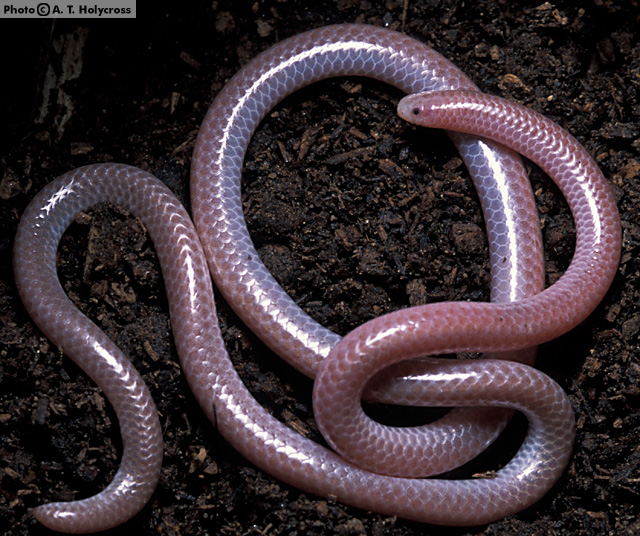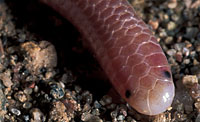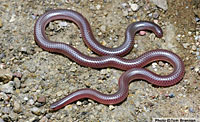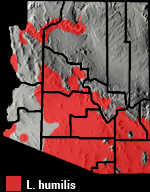Online Field Guide to The Reptiles and Amphibians of Arizona



Maricopa County, AZ
 Maricopa Co., AZ |
| WESTERN THREADSNAKE Leptotyphlops humilis |
Non-Venomous
|
| DESCRIPTION: A small (up to 389 mm or 15″ in total length), relatively thin, pink, gray, or mauve snake that resembles a shiny earthworm. Both the head and tail are rounded and blunt. The head is not distinct from the neck. The eyes are vestigial and appear as dark spots underneath the ocular scales. Unlike most of our snakes the belly scales of this snake are not enlarged. A small spine protrudes from the end of the tail. There are no teeth in the upper jaw and only a few teeth in the lower jaw. This snake has only one scale between the oculars on the top of the head distinguishing it from the similar looking New Mexico Threadsnake which has three scales between the oculars.
DISTRIBUTION: This snake is found across western and southern Arizona at elevations ranging from just above sea level near Yuma to over 5,000′. There are populations that may be isolated in the Verde Valley, Sedona, and Walnut Canyon areas. HABITAT: Arizona’s desertscrub communities, Semidesert Grassland, Interior Chaparral, and the lower reaches of our woodlands are home to this snake. It is usually found below steep mountainous terrain on bajadas, in foothills, canyon bottoms, and low valleys.BEHAVIOR: Primarily nocturnal and crepuscular. It spends the majority of its time burrowed underground. It is encountered on the surface crossing roadways on warm spring evenings. It hibernates during the cold months of late fall and winter. When captured this snake exhibits defensive behaviors that include writhing, releasing musk, and poking with its harmless tail spine.DIET: The Western Threadsnake forages underground for ants, termites, other small insects, centipedes, and spiders. It locates prey by following ant scent trails to the nest.REPRODUCTION: Mating probably takes place in spring. A clutch of up to 8 eggs is laid in summer. This snake sometimes nests communally and females tend to their eggs. SUBSPECIES FOUND IN AZ: SOUTHWESTERN THREADSNAKE Leptotyphlops humilis humilis. This subspecies is found across most of the northwestern and south-central portion of the state. TRANS-PECOS THREADSNAKE Leptotyphlops humilis segregus. This subspecies is found in southeastern Arizona. UTAH THREADSNAKE Leptotyphlops humilis utahensis. This subspecies is found near the Arizona-Utah border in northwestern Arizona. By Thomas C. Brennan Bartlett. 2000. Snakes of North America: Western Brennan, T. C., and A. T. Holycross. 2006. A Field Guide to Amphibians and Reptiles in Arizona. Arizona Game and Fish Department. Phoenix, AZ Brennan, T. C., and A. T. Holycross. 2005. A Field Guide to Amphibians and Reptiles of Maricopa County. Arizona Game and Fish Department. Phoenix, AZ Degenhardt, W. G., Painter, C. W., and Price, A. H.. 1996. Amphibians and Reptiles of New Mexico. University of New Mexico Press. Albuquerque. Fowlie. 1965. The Snakes of Arizona. Azul Quinta Press, Fallbrook, California Stebbins. 1985. Western Reptiles and Amphibians. Houghton Mifflin. New York,NY |
|
Visit Partners in Amphibian and Reptile Conservation:


HOME
Copyright © 2023, Arizona Game and Fish Department. All rights reserved.
If you make use of the textual contents of this site in reports, publications, etc. please cite and credit the author(s) and photographer(s). All photos on this website are copyrighted. However, those found in the species account section may be used for any noncommercial scientific, educational, or conservation purposes provided that photographs are not altered and continue to bear the copyright symbol and name of the photographer. Please contact the photographer regarding commercial use of copyrighted photographs.











